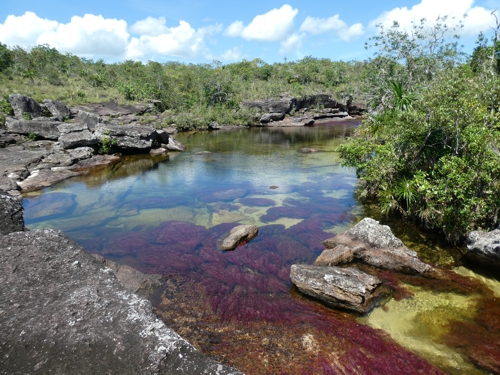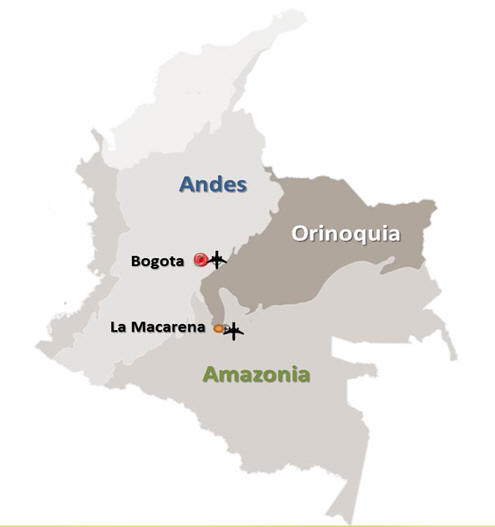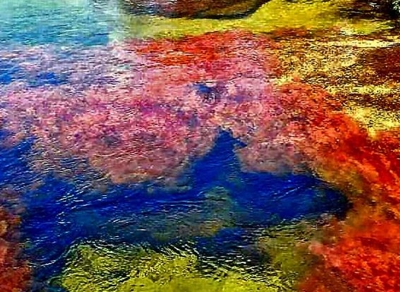

Destinations
Experiences
 |
L A
D A T C O T O U R
S |
 |
||||||||
| HOME | South America | Falkland Islands | Antarctica | Unique Destinations |
Unique Experiences |
Newsstand | ||||
 |
Cano Cristales and Serrania de la
Macarena Colombia
La Manigua Lodge |
 |
 |
 |
 |
|
|
|
|
Caño Cristales (English: Crystal Channel) is a Colombian river located in the Serrania de la Macarena province of Meta, and is a tributary of the Guayabero River. The river is commonly called the "River of Five Colors" or the "Liquid Rainbow," and is noted for its striking colors. The bed of the river from the end of July through November is variously colored yellow, green, blue, black, and especially red, the last caused by Macarenia clavigera plants (family Podostemaceae) on the riverbed.[3]
HISTORY
GEOLOGY Caño Cristales is a fast-flowing river with many rapids and waterfalls. Small circular pits known as giant's kettles can be found in many parts of the riverbed, which have been formed by pebbles or chunks of harder rocks. Once one of these harder rock fragments falls into one of the cavities, it is rotated by the water current and begins to carve at the cavity wall, increasing the dimensions of the pit.
FLORA & FAUNA Caño Cristales river has a wide variety of aquatic plants. The water of the river is extremely clear due to the lack of nutrients and small particles. Almost unique is the bright red - pink coloration of riverbed after the rainy period in the end of June - November. This color is caused by great quantities of endemic plant species Macarenia clavígera. This plant is found in some more local rivers, such as the Caño Siete Machos. These red plants adhere tightly to rocks in places where the river has faster current.
|
---------------------------------------------------------------------
ABOUT LA MACARENA NATIONAL PARK - compliments of Wikipedia:
Serranía de la Macarena is an isolated mountain range located in the Meta Department, Colombia. It was named after the Virgin of Hope of Macarena. The mountains are separated by about 40 km (25 mi) at their northern extreme from the East Andes. The range is orientated from north to south and is 120 km (75 mi) in length and 30 km (19 mi) wide. The highest peak ("El Gobernador", the governor) reaches 2,615 m (8,579 ft) and is the highest point of the Orinoquía Region.The first national reserve in Colombia was established in the central part of the mountain range in accordance with a Congressional Law promulgated in 1948.The status of National Natural Park was designated in 1971 and the protected area encompasses 6,200 km2 (2,400 sq mi).
BIODIVERSITY
The national park encompasses the ecologically unique meeting point for the flora and fauna of the Amazon, Orinoco and Andes regions. The area is of tropical climate and temperatures range from 42 °F (5.5 °C) to 88 °F (31 °C). These aspects help to maintain a high level of biodiversity with numerous endemic and rare specieS.The ecosystems found within the park include rainforest, dry forest, shrublands and savanna. The mountains are home to around 50 known species of orchids, and botanists studying the area have identified more than 2000 other species of plants.
The ecosystem's fauna includes anteaters, jaguars, cougars, deer, 8 species of monkeys, 500 species of birds including the gray-legged tinamou. 1,200 species of insects and 100 species of reptiles.
ECOTOURISM
The La Macarena National and Ecological Reserve Park is internationally known for the Caño Cristales, known by people who has visited it as one of the most beautiful rivers in the world.The park also contains petroglyphs from ancient cultures (Angosturas I and II petroglyphs in the Guayabero River). There are also enormous waterfalls, such as Caño Canoas, El Salto de Yarumales, El Salto del Mico, Soplaculos and others. Most of them are difficult to reach on foot due to the rugged terrain.
Just outside of the city of La Macarena are the Botanical Gardens of La Macarena[6] and the private reserve La Madrevieja de El Carmen, places that offer the possibility of nature tourism involving its visitors in restoration activities.
GEOLOGY
Basement rocks on the east side of the Macarenas include the Precambrian granite of the Guyana Shield in the Guaviare River valley and the San Jose del Guaviare area. The rocks of the shield are overlain by sandstones and conglomerates of the Vaupes Formation of Lower Paleozoic to the lower Oligocene age.
---------------------------------------------------
Serrania de la Macarena - compliments of theculturetrip.com
This 6,200 square kilometer (2,4000 square mile) national park is unique to Colombia – this isolated mountain range in the Meta Department is where the unique flora and fauna of the Amazon Rainforest, the East Llanos and the Andes Mountain range meet. The ecosystems of the rainforest, the dry forest and the shrubland savannas all come together at this point. This combination of ecosystems makes for a biodiverse environment and is home to a large number of endangered and unique species; over 2,000 species of plants, 550 species of birds, 100 reptiles, 1,200 insects, anteaters, jaguars, cougars, deer and eight species of monkey inhabit this unique environment. The most famous part of this National Park is Caño Cristales, or “the river of five colours”: a 100 kilometer (62 mile) stretch of river that is a beautiful combination of yellow, green, red, blue and black.